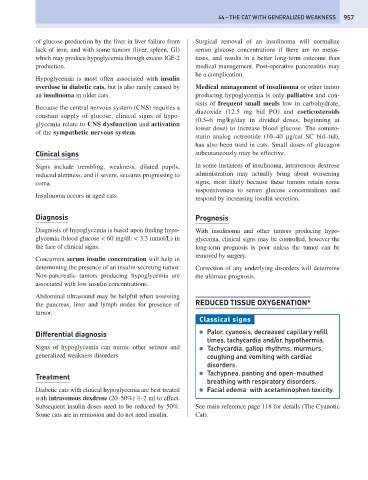Page 965 - Problem-Based Feline Medicine
P. 965
44 – THE CAT WITH GENERALIZED WEAKNESS 957
of glucose production by the liver in liver failure from Surgical removal of an insulinoma will normalize
lack of iron, and with some tumors (liver, spleen, GI) serum glucose concentrations if there are no metas-
which may produce hypoglycemia through excess IGF-2 tases, and results in a better long-term outcome than
production. medical management. Post-operative pancreatitis may
be a complication.
Hypoglycemia is most often associated with insulin
overdose in diabetic cats, but is also rarely caused by Medical management of insulinoma or other tumor
an insulinoma in older cats. producing hypoglycemia is only palliative and con-
sists of frequent small meals low in carbohydrate,
Because the central nervous system (CNS) requires a
diazoxide (12.5 mg bid PO) and corticosteroids
constant supply of glucose, clinical signs of hypo-
(0.5–6 mg/kg/day in divided doses, beginning at
glycemia relate to CNS dysfunction and activation
lower dose) to increase blood glucose. The somato-
of the sympathetic nervous system.
statin analog octreotide (10–40 μg/cat SC bid–tid),
has also been used in cats. Small doses of glucagon
Clinical signs subcutaneously may be effective.
Signs include trembling, weakness, dilated pupils, In some instances of insulinoma, intravenous dextrose
reduced alertness, and if severe, seizures progressing to administration may actually bring about worsening
coma. signs, most likely because these tumors retain some
responsiveness to serum glucose concentrations and
Insulinoma occurs in aged cats.
respond by increasing insulin secretion.
Diagnosis Prognosis
Diagnosis of hypoglycemia is based upon finding hypo- With insulinoma and other tumors producing hypo-
glycemia (blood glucose < 60 mg/dl: < 3.3 mmol/L) in glycemia, clinical signs may be controlled, however the
the face of clinical signs. long-term prognosis is poor unless the tumor can be
removed by surgery.
Concurrent serum insulin concentration will help in
determining the presence of an insulin-secreting tumor. Correction of any underlying disorders will determine
Non-pancreatic tumors producing hypoglycemia are the ultimate prognosis.
associated with low insulin concentrations.
Abdominal ultrasound may be helpful when assessing
the pancreas, liver and lymph nodes for presence of REDUCED TISSUE OXYGENATION*
tumor.
Classical signs
Differential diagnosis ● Palor, cyanosis, decreased capillary refill
times, tachycardia and/or, hypothermia.
Signs of hypoglycemia can mimic other seizure and ● Tachycardia, gallop rhythms, murmurs,
generalized weakness disorders. coughing and vomiting with cardiac
disorders.
● Tachypnea, panting and open-mouthed
Treatment
breathing with respiratory disorders.
Diabetic cats with clinical hypoglycemia are best treated ● Facial edema with acetaminophen toxicity.
with intravenous dexdrose (20–50%) ⁄2–2 ml to effect.
1
Subsequent insulin doses need to be reduced by 50%. See main reference page 118 for details (The Cyanotic
Some cats are in remission and do not need insulin. Cat).

